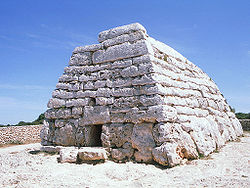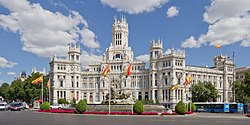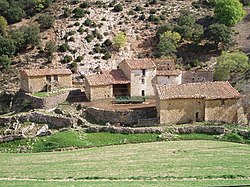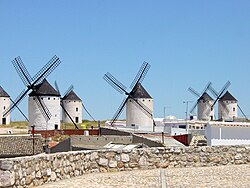Spanish architecture
This article needs additional citations for verification. (April 2022) |


Spanish architecture refers to
A real development came with the arrival of the
Towards the end of the 15th century, and before influencing with its
The 19th century had two faces: the engineering efforts to achieve a new language and bring about structural improvements using iron and glass as the main building materials, and the academic focus, firstly on revivals and
Many architectural sites in Spain, and even portions of cities, have been designated
Prehistory
Megalithic architecture

In the
The best preserved examples of architecture from the
Iberian and Celtic architecture

The most characteristic constructions of the Celts were the
The towns built by the Arévacos were related to Iberian culture, and some of them reached notable urban development like Numantia. Others were more primitive and usually excavated into the rock, like Termantia.
Roman
Urban development

The
Constructions

Roman

Ludic architecture is represented by such buildings as the theatres of
, and many others.Religious architecture also spread throughout the Peninsula; examples include the Roman temples of Barcelona, Córdoba, Vic, and Alcántara,
The main funerary monuments are the Torre dels Escipions in Tarraco, the distyle in Zalamea de la Serena, and the Mausoleum of the Atilii in Sádaba, Zaragoza. Roman triumphal arches can be found in Cabanes, Castellón, Medinaceli, and the Arc de Berà near Roda de Berà.
Pre-Romanesque
The term Pre-Romanesque refers to the Christian art after the
Visigothic architecture
From the 6th century, it is worth mentioning the remains of the Cabeza de Griego basilica, in Cuenca and the small church of San Cugat del Vallés, in Barcelona. This one, although very deteriorated, clearly shows a single nave plan that ends in an apse. From the following century are those of San Pedro de la Nave, San Juan de Baños, Santa María de Quintanilla de las Viñas, whose layout will later be repeated in other later temples belonging to the "repopulation style" (misnamed "Mozarab»). For the rest, at this time the early Christian tradition is basically followed in religious architecture. The most representative buildings can be related to the following:
Church of San Pedro de la Nave in San Pedro de la Nave-Almendra (Zamora)
Church of Santa Comba de Bande (Orense)
Church of San Juan Bautista de Baños de Cerrato (Palencia)
Crypt of San Antolín in the cathedral of Palencia (Palencia)
Church of San Pedro de la Mata de Sonseca (Toledo)
Chapel of Santa María de Quintanilla de las Viñas (Burgos)
Asturian architecture

The kingdom of Asturias arose in 718, when the Astur tribes, rallied in assembly, decided to appoint Pelayo as their leader. Pelayo joined the local tribes and the refuged Visigoths under his command, with the intention of progressively restoring Gothic Order.
Asturian Pre-Romanesque is a singular feature in all Spain, which, while combining elements from other styles as

As regards its evolution, from its appearance, Asturian Pre-Romanesque followed a "stylistic sequence closely associated with the kingdom's political evolution, its stages clearly outlined". It was mainly a
The third period comprises the reigns of
The fourth period belongs to the reign of
Mozarabic architecture
Mozarabic architecture was carried out by the Mozarabs, Christians who lived in Muslim al-Andalus from the Arab invasion (711) until the end of the 11th century, and who maintained their distinct personality also against the Christians of the northern kingdoms, to them that were emigrating in successive waves or being incorporated during the Reconquista. An example of this architecture is the church of Bobastro, a cave temple found in the place known as Mesas de Villaverde, in Ardales (Málaga), of which only a few ruins remain. Another representative building of this architecture is the church of Santa María de Melque, located in the vicinity of La Puebla de Montalbán (Toledo). Regarding this temple, there is doubt in its stylistic affiliation, since it shares Visigoth features with others more properly Mozarabic, its dating being not clear either. The hermitage of San Baudelio de Berlanga presents an unprecedented typology, including in its rectangular plan a tribune over a small hypostyle hall, in the manner of mosques, and its roof is supported by a single central pillar shaped like a palm tree. Both this pillar and the interior walls are profusely decorated with frescoes depicting hunting scenes and exotic animals. A certain typological connection can be established as an initiatory temple, already in Romanesque times, with the church of Santa María de Eunate and other centralized Templar buildings, such as Torres del Río or Vera Cruz de Segovia.
Repopulation architecture

Between the end of the 9th century and the beginning of the 11th century, a number of churches were built in the Northern Christian kingdoms. They are widely but incorrectly known as Mozarabic architecture. This architecture is a summary of elements of diverse extraction irregularly distributed, of a form that in occasions predominate those of paleo-Christian, Visigothic or Asturian origin, while at other times emphasizes the Muslim impression.
The churches have usually basilica or centralized plans, sometimes with opposing
Decoration has resemblance to the Visigothic based in volutes,
Al-Andalus
Emirate and Caliphate of Córdoba
The
In Cordoba, Abd ar-Rahman I built the
The Taifas

The Caliphate disappeared and was split into several small kingdoms called taifas. During this period, art and culture continued to flourish despite the political fragmentation of Al-Andalus.[4] The Aljaferia Palace of Zaragoza is the most significant palace preserved from this period, featuring complex ornamental arcades, multifoil and mixtilinear arches, and stucco decoration. In other cities, a number of important palaces or fortresses were begun or expanded by local dynasties such as the Alcazaba of Málaga and the Alcazaba of Almería. Other examples of architecture from around this period include the Bañuelo of Granada, an Islamic bathhouse.[8]: 116–128
Almoravids and Almohads

The late 11th century saw the significant advance of Christian kingdoms into Muslim al-Andalus, particularly with the fall of Toledo to Alfonso VI of Castile in 1085, and the rise of major Berber empires originating in present-day Morocco. The latter included first the Almoravids (11th–12th centuries) and then the Almohads (12th–13th centuries), both of whom created empires that stretched across large parts of western and northern Africa and took over the remaining Muslim territories of al-Andalus in Europe.[9] This period is considered one of the most formative stages of western Islamic (or "Moorish") architecture, establishing many of the forms and motifs that were refined in subsequent centuries.[7][10][9][11]
Relatively little survives of Almoravid architecture but much more has survived of Almohad architecture.[5] In Seville, the Almohad rulers built a new Great Mosque (later transformed into the Cathedral of Seville), which consisted of a hypostyle prayer hall, a courtyard (now known as the Patio de los Naranjos or Court of Oranges), and a massive minaret tower now known as the Giralda. The minaret was later expanded after being converted into a bell tower for the current cathedral.[12]: 130–133 Other examples of Almohad architecture are found in various fortifications and smaller monuments in southern Spain today, as well as in traces of the former Almohad palace in the Alcazar of Seville.[8] Almohad architecture promoted new forms and decorative designs such as the multifoil arch and the sebka motif, probably influenced by the Caliphate-period architecture of Cordoba.[13]: 232–234, 257–258
Nasrid Emirate of Granada

As the Almohad authority retreated from al-Andalus in the early 13th century, the Christian kingdoms of the north advanced again and Muslim al-Andalus was eventually reduced to the much smaller Nasrid Emirate centered in Granada, where much of the Muslim population took refuge. The palaces of the Alhambra and the Generalife in Granada, built under the Nasrid dynasty, are the most iconic monuments of this period and reflect the last great period of art and architecture in al-Andalus before its final end.[5] The Alhambra complex was begun by Ibn al-Ahmar, the first Nasrid emir, and the last major additions were made during the reigns of Yusuf I (1333–1353) and Muhammad V (1353–1391).[14]: 152
Nasrid architecture continued the earlier traditions of Andalusi architecture while also synthesizing them into its own distinctive style, which had many similarities with the architecture of contemporary dynasties in North Africa such as the
Romanesque

Romanesque architecture appeared early in Spain, in the 10th and 11th centuries, in Lérida,
Later Romanesque architecture arrived with the influence of
Gothic

The Gothic style arrived in Spain in the 12th century. In this time, late Romanesque alternated with a few expressions of pure
The most important post-13th century Gothic styles in Spain are the
Mudéjar
Mudéjar art, also known as Mudéjar style, emerged in the Christian kingdoms of the north in the 12th century and spread with the Christian reconquest of the Iberian Peninsula. The reconquest brought Moorish and Jewish craftsmen under Christian rule who then influenced the architecture of the expanding Christian kingdoms. It is not a style of architecture, the term Mudéjar style refers to the application of Moorish and Jewish styles of decoration or materials to whatever Christian architecture existed at the time. This produced Mudéjar-Romanesque, Mudéjar-Gothic and Mudéjar-Renaissance.

Mudéjar style was highly variable from region to region as different Islamic and Jewish influences were adopted into the Christian architecture of different regions. Mudéjar is characterised by the use of brick as the main building material. The dominant geometrical character, distinctly Islamic, emerged conspicuously in the accessory crafts using cheap materials elaborately worked – tilework, brickwork, wood carving, plaster carving, and ornamental metals. Even after the Muslims and Jews were no longer employed, many of their methods and decorative styles continued to be applied to Spanish architecture.
Mudéjar style was born in the northern town of
Renaissance
In Spain, Renaissance styles began to be grafted onto Gothic forms in the last decades of the 15th century. The forms that started to spread were made mainly by local architects: that is the cause of the creation of a specifically Spanish Renaissance that brought the influence of southern Italian architecture, sometimes from illuminated books and paintings, mixed with the gothic tradition and local idiosyncrasies. The new style was called Plateresque because of the extremely decorated façades that brought to the mind the decorative motifs of the intricately detailed work of silversmiths, the "plateros". Classical orders and candelabra motifs (a candelieri) were combined freely into symmetrical wholes.
In that scenery, the

As decades passed, the Gothic influence disappeared and the research of an orthodox classicism reached high levels. Although Plateresque is a commonly used term to define most of the architectural production of the late 15th and first half of 16th century, some architects acquired a more sober personal style, like
The highlight of Spanish Renaissance is represented by the Royal Monastery of
Baroque

As Italian Baroque influences grew, they gradually superseded in popularity the restrained classicizing approach of Juan de Herrera, which had been in vogue since the late sixteenth century. As early as 1667, the façades of Granada Cathedral (by Alonso Cano) and Jaén Cathedral (by Eufrasio López de Rojas) suggest the artists' fluency in interpreting traditional motifs of Spanish cathedral architecture in the Baroque aesthetic idiom.
Vernacular Baroque with its roots still in the Herrerian style and in traditional brick construction was developed in Madrid throughout the 17th century. Examples include
In contrast to the art of Northern Europe, the Spanish art of the period appealed to the emotions rather than seeking to please the intellect. The Churriguera family, which specialized in designing altars and retables, revolted against the sobriety of the Herrerian classicism and promoted an intricate, exaggerated, almost capricious style of surface decoration known as the Churrigueresque. Within half a century, they transformed Salamanca into an exemplary Churrigueresque city.
The evolution of the style passed through three phases. Between 1680 and 1720, the Churriguera popularized Guarini's blend of Solomonic columns and Composite order, known as the "supreme order". Between 1720 and 1760, the Churrigueresque column, or estipite, in the shape of an inverted cone or obelisk, was established as a central element of ornamental decoration. The years from 1760 to 1780 saw a gradual shift of interest away from twisted movement and excessive ornamentation toward a neoclassical balance and sobriety.

Two of the most eye-catching creations of Spanish Baroque are the energetic façades of the
The
Rococo
Neoclassical
The extremely intellectual postulates of
Spanish Viceroyal architecture in America and Pacific
The combination of the Native American and Moorish decorative influences with an extremely expressive interpretation of the Churrigueresque idiom may account for the full-bodied and varied character of the Baroque in the American kingdoms and provinces of the Spanish Monarchy. Even more than its Spanish counterpart, American Baroque developed as a style of stucco decoration. Twin-towered façades of many American cathedrals of the seventeenth century had Renaissance roots and the full-fledged Baroque did not appear until 1664, when the Jesuit shrine on Plaza de Armas in Cusco was built.
In the Viceroyalty of

To the north, by 18th-century the richest Viceroyalty of
The true capital of
Spanish Chinese influence exclusive to
19th century
Eclecticism and Regionalism

During the second half of the 19th century, the
, and so on.This led to a particular new style made of the mixture of several old styles in the same construction: the Eclecticism. It is difficult to trace a clear line to separate styles as Modernisme, Industrial iron architecture and Eclecticism, as very often architects took some features of several of them for their works. This is the case of Antonio Palacios, co-designer with Joaquín Otamendi of the Palace of Communications of Madrid, inaugurated in 1909. Other works of Palacios include the Círculo de Bellas Artes, the Río de la Plata Bank, the Hospital of Maudes, all of them in Madrid.
In the first half of the 20th century, another wave of revivals emerged, mainly after the Iberoamerican Exhibition of Seville in 1929: the Regionalism. Features of the different regional vernacular architectures took then the protagonism.
Neo-Mudéjar
In the late 19th century a new architectural movement emerged in Madrid as a revival of the Mudéjar architecture. The Neo-Mudéjar soon spread to other regions of the country. Architects such as Emilio Rodríguez Ayuso perceived the Mudéjar as a characteristic and exclusive Spanish style. They started to construct buildings using some of the features of the ancient style, as horseshoe arches and the use of the abstract shaped brick ornamentations for the façades. It became a popular style for bull rings and for other public constructions, but also for housing, due to its cheap materials, mainly brick for exteriors.
The Neo-Mudéjar was often combined with
Architecture of glass and iron
During the
20th century

Catalan Modernisme
When the city of
Other notable Catalan architects of that period include
Contemporary architecture
The creation in 1928 of the

At the 1929 Barcelona International Exposition, the German pavilion designed by Ludwig Mies van der Rohe became an instant icon, amalgamating Rohe's minimalism and notions of truth to materials with a De Stijl influenced treatment of planes in space. The large overhanging roof famously 'hovers' apparently unsupported.
During and after the Spanish Civil War and World War II, Spain found herself both politically and economically isolated. The consequent effect of which, in tandem with Franco's preference for "a deadening, nationalistic sort of classical kitsch", was to largely suppress progressive modern architecture in Spain.[24] Nevertheless, some architects were able to reconcile advances in construction with official approval, notably in the prolific output of Gutiérrez Soto whose interest in topology and rational distribution of space effectively alternated historical revivals and rationalist imagery with ease. Luis Moya Blanco's achievements in the construction with brick vaults deserve also a mention. His interest in traditional brick construction led him to a deep investigation into the modern formal possibilities of that material.
In the last decades of the Franco's life, a new generation of architects rescued the legacy of the GATEPAC with strength: Alejandro de la Sota was the pioneer in that new way, and young architects as Francisco Javier Sáenz de Oiza, Fernando Higueras and Miguel Fisac, often with modest budgets, investigated in prefabrication and collective housing typos.

The death of Franco and the return of democracy brought a new architectural optimism to Spain in the late 1970s and 1980s. Critical regionalism became the dominant school of thought for serious architecture.[25] The influx of money from EU funding, tourism and a flowering economy strengthened and stabilised Spain's economic base, providing fertile conditions for Spanish architecture. A new generation of architects emerged, amongst whom were Enric Miralles, Carme Pinós, and the architect/engineer Santiago Calatrava. The 1992 Barcelona Olympics and the World's Fair in Seville, further bolstered Spain's reputation on the international stage, to the extent that many architects from countries suffering from recessions, moved to Spain to assist in the boom. In recognition of Barcelona's patronage of architecture, the Royal Institute of British Architects awarded the Royal Gold Medal to Barcelona in 1999, the first time in its history the award was made to a city.[26]

Bilbao attracted the Solomon R. Guggenheim Foundation to construct a new art museum, which opened in 1997. Designed by Frank Gehry in a deconstructivist manner, the Guggenheim Museum Bilbao became world-famous and single-handedly raised the profile of Bilbao on the world stage. Such was the success of the museum that the construction of iconic architecture in towns aspiring to raise their international profile has become a recognised town planning strategy known as the "Bilbao effect".[27]
In 2003, the
Famous Spanish architects of the 20th century
- Antoni Gaudí (1852–1926)
- Lluis Domenech i Montaner(1850–1923)
- Secundino Zuazo (1887–1971)
- Antonio Palacios (1874–1945)
- Casto Fernández-Shaw (1896–1978)
- Josep Lluis Sert(1902–1983)
- Josep Antoni Coderch (1913–1984)
- Luis Gutiérrez Soto (1890–1977)
- Alejandro de la Sota (1913–1996)
- Miguel Fisac (1913–2006)
- Francisco Javier Sáenz de Oiza (1918–2000)
- Julio Cano Lasso (1920–1996)
- Fernando Higueras (1929–2008)
- Pritzker Prizein 1996
- Ricardo Bofill (1939–2022)
- Mariano Bayón (1942)
- Alberto Campo Baeza (1946)
- Santiago Calatrava (1951)
- Adolfo Moran (1953)
- Enric Miralles (1955–2000)
- Mansilla+Tuñón
- Alejandro Zaera(1963)
- Rafael Aranda; Pritzker Prize in 2017
21st century
In 2006, the exhibition "On-Site: New architecture in Spain" was held in the

In 2006, Terminal 4 of
In 2011 the Oscar Niemeyer International Cultural Centre was inaugurated in Avilés, Asturias. This is the only work of the Brazilian architect Oscar Niemeyer in Spain. It has five elements: an open square, a dome, a tower, an auditorium and a multi-purpose building.
Vernacular architecture
Due to the climatic and topographic differences throughout Spain, the
-
The casona montañesa, stone house typical of Cantabria.
-
An apartment withLas Palmas de Gran Canaria, Canary Islands.
-
Windmills of Campo de Criptana, La Mancha.
See also
- Architecture of Madrid
- Architecture of Cantabria
- List of missing landmarks in Spain
- Rafael Manzano Prize
- Superior Technical School of Architecture of Madrid
- Spanish art
- The Cerdá Plan
Further reading
- New Architecture in Spain (PB) - Edited and with essay by Terence Riley. ISBN 0-87070-499-0
- Carver, Norman F. Jr. (1982) Iberian Villages Portugal & Spain. Document Press Ltd. ISBN 0-932076-03-3
- Chueca Goitia, Fernando: Historia de la arquitectura española, two volumes. Diputación de Ávila, 2001. ISBN 84-923918-7-1
- Kubler, George. Building the Escorial. Princeton NJ 1982.
- Newcomb, Rexford (1937). Spanish-Colonial Architecture in the United States. J.J. Augustin, New York. Dover Publications; Reprint edition (April 1, 1990). ISBN 0-486-26263-4
- Rosenthal, Earl. The Palace of Charles V in Granada. Princeton NJ 1985.
- Soria, Martín and George Kubler, Art and Architecture in Spain and Portugal and their American Dominions, 1500-1800. Harmondsworth 1959.
- Zabalbeascoa, Anatxu (1996). Igualada Cemetery: Barcelona, 1986-90 - Enric Miralles and Carme Pinos (Architecture in Detail S.) (Paperback). Phaidon Press. p. 60 pages. ISBN 0-7148-3281-2.
References
- ^ "A picture of a Celtiberian .about.com/library/graphics/numantia_3.jpg".
- ISBN 84-95312-32-8
- ISBN 9781317870418.
- ^ ISBN 9780465055876.
- ^ ISBN 9780300218701.
- ISBN 9780812207286.
- ^ a b Marçais, Georges (1954). L'architecture musulmane d'Occident. Paris: Arts et métiers graphiques.
- ^ ISBN 3822896322.
- ^ ISBN 9780748646821.
- ^ Salmon, Xavier (2018). Maroc Almoravide et Almohade: Architecture et décors au temps des conquérants, 1055–1269. Paris: LienArt.
- ^ Basset, Henri; Terrasse, Henri (1932). Sanctuaires et forteresses almohades. Paris: Larose.
- ISBN 9780300218701.
- ^ Marçais, Georges (1954). L'architecture musulmane d'Occident (in French). Paris: Arts et métiers graphiques.
- ^ ISBN 9780300218701.
- ISBN 9780190624552.
- ISBN 9780674063600.
- ^ ISBN 9788492441129.
- ISBN 84-237-0459-9
- ISBN 84-600-4134-4/ 8460041344 Instituto Egipcio de Estudios Islámicos en Madrid
- ^ Garma, David de la. "Arquitectura Mudejar (ARTEGUIAS)". www.arteguias.com. Archived from the original on 2016-02-05.
- ISBN 84-376-1801-0
- ISBN 0-7735-1712-X
- ^ "Archived copy" (PDF). Archived from the original (PDF) on 2006-12-06. Retrieved 2006-12-20.
{{cite web}}: CS1 maint: archived copy as title (link) - ^ Forgey, Benjamin (12 February 2006). "Gains in Spain: Once-Staid Architecture Soars Ahead of the Curve". Archived from the original on 17 June 2006 – via www.washingtonpost.com.
- ^ Zabalbeascoa
- ^ list of medal winners (PDF) Archived 2006-12-16 at the Wayback Machine
- ^ Bacharach, Jacob (2002) The Bilbao Effect Archived 2006-11-13 at the Wayback Machine
- ^ "De Nueva York a Sidney". eldia.es. 28 September 2003. Archived from the original on 16 July 2011.
- ^ "Museum of Modern Art - MoMA". www.moma.org. Archived from the original on 2010-01-22.
- ^ Internet, Unidad Editorial. "España se olvida del 'ladrillo' - Vivienda - elmundo.es". www.elmundo.es. Archived from the original on 2010-06-26.






